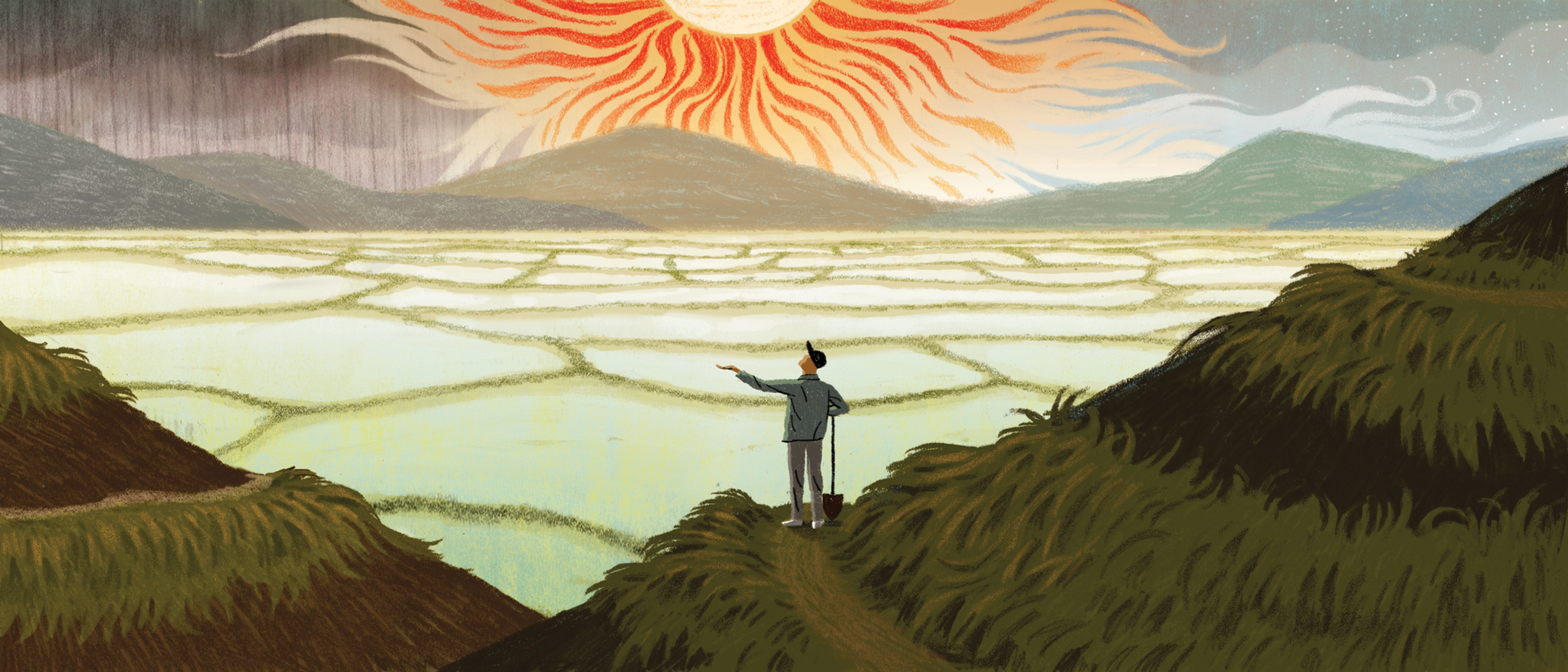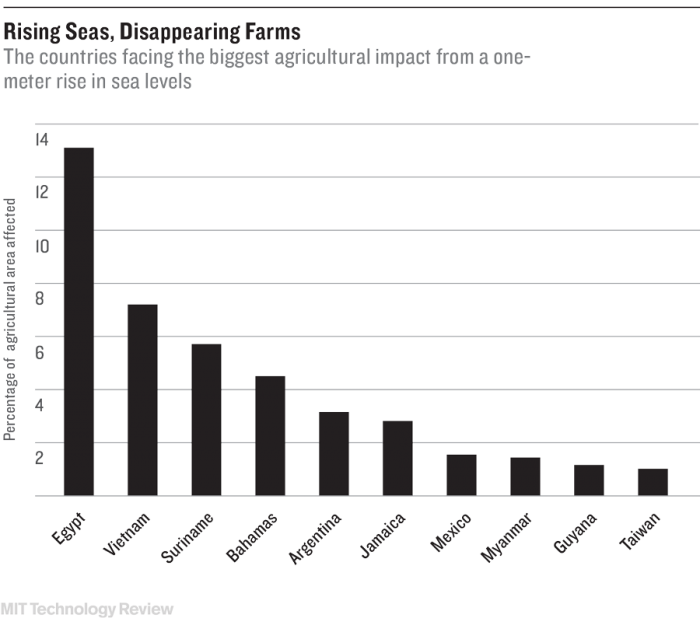Snow in Vietnam and Other New Climate Patterns Threaten Farmers

At around 5:00 each morning, loudspeakers crackle on in Ma Village, Vietnam (population 731). Mounted on concrete poles atop hilltops—a remnant of the 1950s information and propaganda apparatus—these loudspeakers, rather than the smartphones popular with Hanoi’s young office workers, are what provide locals in this mountain village with important news bulletins.
In the hour before sunrise, as farmers prepare to leave for their fields, village chief Nguyen Van Tam reads out weather updates and planting directives from the local meteorological bureau. In recent years, these once-routine broadcasts have contained increasingly bizarre information.
In January, for instance, when northern Vietnam saw its coldest temperatures on record, dipping below freezing in the mountains, Nguyen urged farmers to “keep your buffalos and cows in the shed—do not take them to the field,” he recalls. As the strange frigid spell continued, he warned villagers to delay transplanting paddy rice, lest seedlings perish in the cold. The previous summer, when he informed the community of record high temperatures amid an ongoing heat wave, there was little to be done to protect crops already in the ground. And last November, when heavy rains fell during what is usually the dry season, he could only describe the extent of the flooding that soaked and destroyed a hectare of maize.
Sitting at a wooden table in the village community hall in late March, below a portrait of revolutionary leader Ho Chi Minh, Nguyen, a congenial 58-year-old wearing a black sports jacket and baseball cap, explained that his duties as an elected official now include “teaching about climate risk.” He knows that global weather systems are shifting—the past year’s temperature extremes and unusual downpours in Vietnam result from a combination of climate change and El Niño—and that this has immediate, sometimes devastating, impacts on the 192 households in his village, mostly farming families in concrete homes with palm-frond roofs.
Vietnam is long and skinny, like an elongated “S” hugging the South China Sea, and it spans multiple climate zones. It has strong textile, footwear, and electronics industries, but the country is also an important exporter of agricultural products including coffee, rice, cashew nuts, pepper, and cassava starch. While farmers in the mountainous north worry about drought and erosion, those in the Mekong Delta region are concerned about sea-level rise and saltwater intrusion into rice paddies. Across South and East Asia, an area home to roughly half the world’s population, the alternation between a relatively dry winter and a wet summer is controlled by monsoon winds. The speed and direction of these winds is driven by the difference between land and sea temperatures. In spring and summer, as the Asian land mass warms more quickly than the surrounding seawater, winds blow inland from the Indian Ocean, bringing rain. But today, as average global temperatures increase, this gradient is in flux, altering the timing, intensity, and predictability of monsoon rains. In a destabilized climate system, temperature extremes are also more common, as are freak rain events like last November’s flooding in Ma Village.

Over many centuries, Vietnam’s farmers carefully chose their crops and planting times to suit the rhythm of the monsoons. In the mountainous northern province of Yen Bai, where Ma Village is located, there are typically two rice seasons, with the first planting in February and the second in late June. Now “the rainfall pattern has changed,” says Nguyen. Recently the rains have come inconsistently, arriving up to several weeks later—meaning, in some years, a prolonged spring drought that imperils the first harvest. Meanwhile, summer rains have fallen on fewer days, but the rain that comes has generally been heavier.
When rains come earlier or later than expected, it interferes with plant growth cycles, which require moisture at precise stages. Crops are also more vulnerable to temperature extremes at specific times.
On a morning in late March, Lam Thi Minh, a 47-year-old farmer wearing rubber boots and a floppy cloth hat, is pulling weeds in a lowland rice paddy. “Normally by this time there should be rain, but not yet this year,” she says, sounding worried. She recalls that two or three years ago, very dry weather during the delicate heading stage of rice growth interfered with the plants’ development. Her rice yields decreased about 30 percent, she says.
Another farmer, 41-year-old Tran Trung Kien, strolling through his pomelo orchard with clucking chickens roaming about underfoot, echoes a similar concern. “The fruit setting will be affected without rain,” he says, referring to the growth stage after pollination that determines whether a tree produces fruit.
Last year, rains were delayed by more than a month, bringing another problem: the long dry spell allowed a new pest to thrive, hurting the spring cassava harvest. Red mites “prefer dry conditions,” bemoans Nguyen. “The mites only died when the rains finally appeared.” That season, cassava yields decreased by nearly half, he says. Another factor that may have depressed yields is erosion, exacerbated by intense summer downpours.
Today, Ma Village is beginning to test simple ways of adapting to climate change, in partnership with the International Center for Tropical Agriculture (CIAT), a global research institute with regional offices in Hanoi. On a steep hillside plot, Nguyen Duy Nhiem, a CIAT researcher who has lived in the village for six months (he is not directly related to the village chief), is building narrow earth mounds at regular intervals, on which grass will be planted. The idea is that grassy strips crisscrossing the cassava field will help limit erosion by trapping dirt. At the bottom of the field, Nguyen has helped construct a ditch lined with plastic to see how much soil is eroded. Over the next three years, his team will monitor trapped sediment and cassava yields to test whether redistributing retained topsoil on the field
improves harvests.
Back at the CIAT office in Hanoi, soil scientist Bui Vinh Le and his team will measure soil from the same fields for the relative levels of carbon, nitrogen, phosphorous, and other elements that improve soil productivity. The impacts of recent changes in the monsoons—fewer days of rain, but more dramatic summer rainfall—are amplified by geography, in this case the mountainous landscape,
he says.
“There are still normal years that allow farmers to follow their [previous] seasonal plans, but there are abnormal years … this abnormality is hard to be predicted or foreseen by farmers,” says Bui.
The Ministry of Agriculture and Rural Development in Hanoi now takes climate change into account when promulgating central plans for agriculture. “Forecasting is important—we have to be flexible,” says Pham Tien Duy, vice chairman for agriculture of Mau Dong commune (a commune is the administrative level above a village). “I try to see if an area will have enough water or not, and if the forecast is dry, I advise changing from rice to maize for a season,” since maize is less water intensive. Pham says that forecasts can also help inform decisions about when and whether to test drought-tolerant and cold-tolerant rice varieties.
The winter’s brutal cold snap also stunned officials in a district near Ma Village. In January, unprecedented snow fell on mountains above 900 meters. Doan Van Thuy, vice chairman for agriculture in the Yan Ten district of Yen Bai province, who is in his 50s, reports that at least 60 cows and buffalo died in his ward, and 300 hectares of rice seedlings were destroyed. “I never saw snow before,” he says.
Keep Reading
Most Popular
Large language models can do jaw-dropping things. But nobody knows exactly why.
And that's a problem. Figuring it out is one of the biggest scientific puzzles of our time and a crucial step towards controlling more powerful future models.
How scientists traced a mysterious covid case back to six toilets
When wastewater surveillance turns into a hunt for a single infected individual, the ethics get tricky.
The problem with plug-in hybrids? Their drivers.
Plug-in hybrids are often sold as a transition to EVs, but new data from Europe shows we’re still underestimating the emissions they produce.
Stay connected
Get the latest updates from
MIT Technology Review
Discover special offers, top stories, upcoming events, and more.